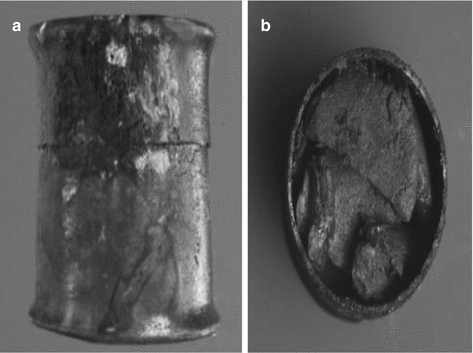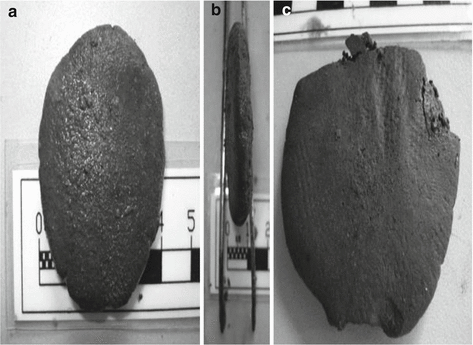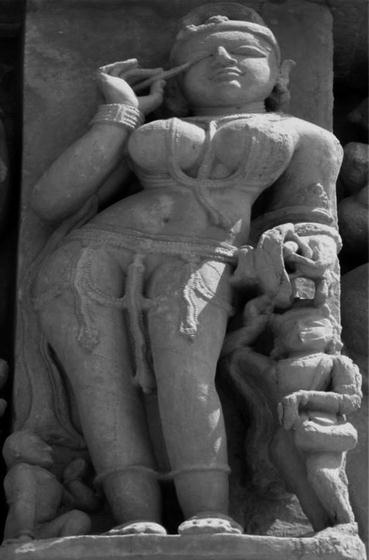Fig. 1.1
Picture showing boxwoods recovered from the shipwrecked Relitto del Pozzino can be seen on display at the Archaeological Museum of Populonia in Piombino, Italy
The boat was found to have various pharmacological preparations along with a surgery hook, a mortar 136 wooden drug vials, and in particular several tin boxes (pyxides) (Fig. 1.2). X-ray examination of the tin boxes revealed the presence of well-preserved circular tablets in dry form even after resting in the seafloor for such a long time of 2000 years. Interestingly, five grey disc-shaped tablets enclosed in the watertight tin pyxis lying on the seabed of the Baratti Gulf wrapped in dense marine flora revealed a rare archaeological finding about the medicine used 2120 years before (Fig. 1.3). Subjecting them for chemical analysis using advanced analytical instruments revealed extraordinary information on the composition of the tablets and on their possible therapeutic use. Hydrozincite (zinc hydroxycarbonate) and smithsonite (zinc carbonate) were two of the most abundant ingredients of the Pozzino tablets, along with starch, animal and plant lipids, and pine resin. From the composition, the authors reached a conclusion that the Pozzino tablets were used for ophthalmic purposes.



Fig. 1.2
Airtight tin container kept in a boxwood stored aboard of a Roman vessel that was shipwrecked off the coast of Tuscany more than 2,000 year ago. The A/6 pyxis before it was opened (a) and the pyxis showing it content (b) (Gianna et al. 2013; reproduced with permission)

Fig. 1.3
Picture showing grey tablets, each about the shape of a circular makeup sponge, inside an airtight tin container stored aboard a Roman vessel that was shipwrecked off the coast of Tuscany more than 2,000 year ago. (a) The Front (b) side & (c) back view profile of tablet found in the A/6 pyxis (Giachi et al. 2013 reproduced with permission). Note: chemical analyses revealed the presence of starch, pine resin, beeswax, and fats in the ancient drugs, with higher amount of zinc compounds indicating that it might have been used to treat eye infections
Concurrently Roman oculist stamps demonstrate a classification of ocular disease, a system of treatment, and reveal the names of practitioners (Marmion 1995). Roman oculist stamps were associated with collyria, and collyrium stamps are parallelepipedic stones that were used in the Roman world, between the second part of the first century and the fourth century A.D., to stamp eye medicine (Perez-Cambrodi et al. 2013). The Latin expression collyrium (eyewash) comes from the Greek name κo λλυ′ ρα, which means “small round loaves” (Giachi et al. 2013). These seals specifically those of Roman eye medicine were inscribed according to the Greek medical tradition indicating the name of the patient, therapeutic instructions, method of administration, etc. Thus, the Greek medical texts reveal the influence of the Greek ophthalmology on Roman eye medicine (Pardon-Labonnelie 2014). Collyrium also refers to the composition of powders brought to a pasty consistence with a liquid and formed into tentlike structure for insertion into (Murube J, 2007a).
Another usage of the vocabulary of collyrium refers to Keshanjana (collyrium), an Ayurvedic formulation prepared out of Keshamasi (ash prepared by scalp hairs) mixed with Goghrita (cow ghee). This particular preparation is indicated for treating Chushkashipaka (dry eye syndrome) in Vagbhatta Samhitas and classical Ayurvedic treatises (Kartar et al. 2014). Ayurvedic and Siddha medical systems originated from different parts of India reported several medicines for ocular use (Subbarayappa 1997; Ven Murthy et al. 2010). Ayurveda dates back to the Vedic period of the Indus Valley Civilization (about 3000 BC) and has been passed on through generations of oral tradition, like the other four sacred texts (Rigveda, Yajurveda, Samaveda, and Atharvanaveda) which were composed between the twelfth and seventh century BC (Ven Murthy et al. 2010).
In the ancient Indian Ayurvedic texts, Shalakya tantra is referred as one among Ashtang Ayurveda (eight super specialities) specifically for the diagnosis, treatment, and prevention of all the diseases occurring above the neck such as eyes, nose, ear, mouth, and head. According to the Vedic scripts, the father of Shalakya tantra was referred as King Nimi (king of Videha). Among the eight super speciality disciplines, Netra Chikitsa is considered as referring to the treatment for ocular diseases.
Anjanam is an ancient Ayurvedic eyeliner and paint explained for cleansing and therapeutic purposes (Fig. 1.4). Although it has been known to exist in the ancient Ayurvedic literature, its relevance to the origin of its use has not been studied systematically. Although the effects of plants with psychoactive substances have been manifested in many ways, one account in Indian Ayurvedic literature details about the use of Datura. “Harita Samhita” explains, Datura root is crushed in water and strained liquid is used in instilling in sore eyes (conjunctivitis). Cannabis extract was used for sore eyes by the Egyptians around 2000 BC (Webley K 2010). They have also used squill for dropsy under the mystic name of the “Eye of Typhon.”


Fig. 1.4
The tenth century carving on stone at Parshvanath temple, Madhya Pradesh, India, showing an Apsaras (angel) applying kajal (collyrium)
Chinese philosopher Mo-Zi (fifth to fourth century BC), recorded the effects of pharmaceutical substances on the quality of eyes “there is a drug for this. if one eats it, the eye will become sharp and the eye will be clear.”. However, the Wan wu text among the Fu-yang bamboo manuscripts found in the tomb of Xiahou Zao, the Lord of Ruyin who died in 165 BC, quotes the recommendation “Ox gall brightens the eye so that one may climb on high on slip thirty-five” (Shaughnessy 2014).
In a Celtic leech-book preserved in the University of Leyden (nineteenth century), shows the treatment for the dimness for eyes. One of the formulations contained pound fennel roots, mixed with honey and boiled over slow fire, with cistern water or woman’s milk and smearing eyes with the fat of a fox (Adipe vulpis). Another remedy claims a mixture of a child’s urine (lotium infantis) with the best honey; add a decoction of fennel roots (Thompson 1897).
An excellent recipe for sore eyes was the juice of the calyx of the red honeysuckle prescribed in 1553. The flowers had to have been gathered kneeling and repeating nine Paternosters in honor of the Trinity, nine more “to greet our Ladye,” and a creed. The abovementioned My Ladye Falkenbrydge’s recipe for eyewater was thus much esteemed and ran as: “Corne-flowers gathered with their cuppes and bruyse them; macerate them in snow or snow water for twenty-four hours, then dystyl in a moderate sandebath and applye it night and morning” (Thompson 1897).
Interestingly the old apothecary’s prescriptions in 1685 were composed of strange ingredients, including crab’s eyes and boar’s teeth, or powdered pearls, and viper broth (Thompson 1897).
At the same time, eyedrops were also used miraculously to cure dental pain. A writer of the Time states that the itinerant dentist was also a well-known figure at the street corner. For 100 marks, he would put out both your eyes and quite cure your inflammation with one drop of his aqua mirabilis, at 12 pence a drop (fifteenth century).
Over a period of centuries, eye diseases were not classified; especially the two major problems were not clearly differentiated. It is somewhere in 1820 that a clear differentiation between glaucoma and cataract was seen in the history. The earliest understanding towards the usage of any substance having a meaningful ocular use come from the observations of the Greek women. The Greek women used the juice of the berries of Atropa belladonna to enlarge their pupils for cosmetic reasons. In Italy belladonna refers to “beautiful lady.” The alluring beauty of Queen Cleopatra of the last century BCE has been attributed to her dilated pupils by using the extracts from the Egyptian henbane (Hyoscyamus niger). Friedlieb Ferdinand Runge, a German chemist, demonstrated the mydriatic effect of the extract of the deadly nightshade in 1819. Atropine in its crystalline form was isolated in 1831 by the German pharmacist Heinrich F. G. Mein. However, atropine has been used for more than a century now by ophthalmologists throughout the world for dilating iris.
It is interesting to know that the knowledge about the dilation property of belladonna was existing for long among the Greek women for making themselves attractive. The same practice has been continued even today when modern photographers use the same technique to make female portraits with attractive eyes. Discovery of contact lenses make this practice in modern times more comfortable by largely using cosmetic contact lenses to give the illusion of dilated eyes. The rationale for the hypothesis came from the investigations of Tombs and Silverma (2004) that the reproductive strategies of males are best served by unequivocal female sexual interest and arousal indicated by dilated pupils (Tombs and and Silverma 2004).
< div class='tao-gold-member'>
Only gold members can continue reading. Log In or Register to continue



